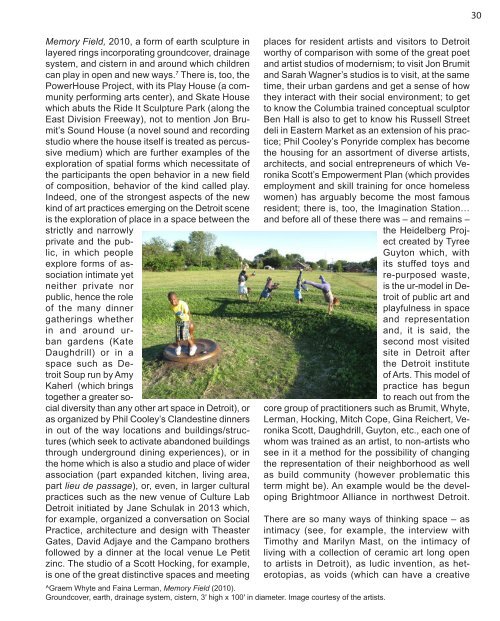Detroit Research Volume 1
You also want an ePaper? Increase the reach of your titles
YUMPU automatically turns print PDFs into web optimized ePapers that Google loves.
30<br />
Memory Field, 2010, a form of earth sculpture in<br />
layered rings incorporating groundcover, drainage<br />
system, and cistern in and around which children<br />
can play in open and new ways. 7 There is, too, the<br />
PowerHouse Project, with its Play House (a community<br />
performing arts center), and Skate House<br />
which abuts the Ride It Sculpture Park (along the<br />
East Division Freeway), not to mention Jon Brumit’s<br />
Sound House (a novel sound and recording<br />
studio where the house itself is treated as percussive<br />
medium) which are further examples of the<br />
exploration of spatial forms which necessitate of<br />
the participants the open behavior in a new field<br />
of composition, behavior of the kind called play.<br />
Indeed, one of the strongest aspects of the new<br />
kind of art practices emerging on the <strong>Detroit</strong> scene<br />
is the exploration of place in a space between the<br />
strictly and narrowly<br />
private and the public,<br />
in which people<br />
explore forms of association<br />
intimate yet<br />
neither private nor<br />
public, hence the role<br />
of the many dinner<br />
gatherings whether<br />
in and around urban<br />
gardens (Kate<br />
Daughdrill) or in a<br />
space such as <strong>Detroit</strong><br />
Soup run by Amy<br />
Kaherl (which brings<br />
together a greater social<br />
diversity than any other art space in <strong>Detroit</strong>), or<br />
as organized by Phil Cooley’s Clandestine dinners<br />
in out of the way locations and buildings/structures<br />
(which seek to activate abandoned buildings<br />
through underground dining experiences), or in<br />
the home which is also a studio and place of wider<br />
association (part expanded kitchen, living area,<br />
part lieu de passage), or, even, in larger cultural<br />
practices such as the new venue of Culture Lab<br />
<strong>Detroit</strong> initiated by Jane Schulak in 2013 which,<br />
for example, organized a conversation on Social<br />
Practice, architecture and design with Theaster<br />
Gates, David Adjaye and the Campano brothers<br />
followed by a dinner at the local venue Le Petit<br />
zinc. The studio of a Scott Hocking, for example,<br />
is one of the great distinctive spaces and meeting<br />
places for resident artists and visitors to <strong>Detroit</strong><br />
worthy of comparison with some of the great poet<br />
and artist studios of modernism; to visit Jon Brumit<br />
and Sarah Wagner’s studios is to visit, at the same<br />
time, their urban gardens and get a sense of how<br />
they interact with their social environment; to get<br />
to know the Columbia trained conceptual sculptor<br />
Ben Hall is also to get to know his Russell Street<br />
deli in Eastern Market as an extension of his practice;<br />
Phil Cooley’s Ponyride complex has become<br />
the housing for an assortment of diverse artists,<br />
architects, and social entrepreneurs of which Veronika<br />
Scott’s Empowerment Plan (which provides<br />
employment and skill training for once homeless<br />
women) has arguably become the most famous<br />
resident; there is, too, the Imagination Station…<br />
and before all of these there was – and remains –<br />
the Heidelberg Project<br />
created by Tyree<br />
Guyton which, with<br />
its stuffed toys and<br />
re-purposed waste,<br />
is the ur-model in <strong>Detroit</strong><br />
of public art and<br />
playfulness in space<br />
and representation<br />
and, it is said, the<br />
second most visited<br />
site in <strong>Detroit</strong> after<br />
the <strong>Detroit</strong> institute<br />
of Arts. This model of<br />
practice has begun<br />
to reach out from the<br />
core group of practitioners such as Brumit, Whyte,<br />
Lerman, Hocking, Mitch Cope, Gina Reichert, Veronika<br />
Scott, Daughdrill, Guyton, etc., each one of<br />
whom was trained as an artist, to non-artists who<br />
see in it a method for the possibility of changing<br />
the representation of their neighborhood as well<br />
as build community (however problematic this<br />
term might be). An example would be the developing<br />
Brightmoor Alliance in northwest <strong>Detroit</strong>.<br />
There are so many ways of thinking space – as<br />
intimacy (see, for example, the interview with<br />
Timothy and Marilyn Mast, on the intimacy of<br />
living with a collection of ceramic art long open<br />
to artists in <strong>Detroit</strong>), as ludic invention, as heterotopias,<br />
as voids (which can have a creative<br />
^Graem Whyte and Faina Lerman, Memory Field (2010).<br />
Groundcover, earth, drainage system, cistern, 3′ high x 100′ in diameter. Image courtesy of the artists.





